Yushu Li
Efficient and Context-Aware Label Propagation for Zero-/Few-Shot Training-Free Adaptation of Vision-Language Model
Dec 24, 2024Abstract:Vision-language models (VLMs) have revolutionized machine learning by leveraging large pre-trained models to tackle various downstream tasks. Despite improvements in label, training, and data efficiency, many state-of-the-art VLMs still require task-specific hyperparameter tuning and fail to fully exploit test samples. To overcome these challenges, we propose a graph-based approach for label-efficient adaptation and inference. Our method dynamically constructs a graph over text prompts, few-shot examples, and test samples, using label propagation for inference without task-specific tuning. Unlike existing zero-shot label propagation techniques, our approach requires no additional unlabeled support set and effectively leverages the test sample manifold through dynamic graph expansion. We further introduce a context-aware feature re-weighting mechanism to improve task adaptation accuracy. Additionally, our method supports efficient graph expansion, enabling real-time inductive inference. Extensive evaluations on downstream tasks, such as fine-grained categorization and out-of-distribution generalization, demonstrate the effectiveness of our approach.
On the Adversarial Risk of Test Time Adaptation: An Investigation into Realistic Test-Time Data Poisoning
Oct 07, 2024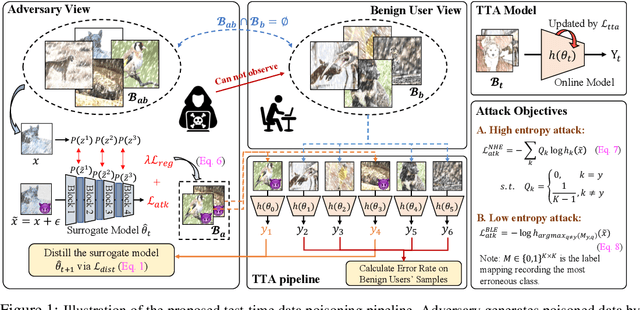



Abstract:Test-time adaptation (TTA) updates the model weights during the inference stage using testing data to enhance generalization. However, this practice exposes TTA to adversarial risks. Existing studies have shown that when TTA is updated with crafted adversarial test samples, also known as test-time poisoned data, the performance on benign samples can deteriorate. Nonetheless, the perceived adversarial risk may be overstated if the poisoned data is generated under overly strong assumptions. In this work, we first review realistic assumptions for test-time data poisoning, including white-box versus grey-box attacks, access to benign data, attack budget, and more. We then propose an effective and realistic attack method that better produces poisoned samples without access to benign samples, and derive an effective in-distribution attack objective. We also design two TTA-aware attack objectives. Our benchmarks of existing attack methods reveal that the TTA methods are more robust than previously believed. In addition, we analyze effective defense strategies to help develop adversarially robust TTA methods.
Exploring Human-in-the-Loop Test-Time Adaptation by Synergizing Active Learning and Model Selection
May 29, 2024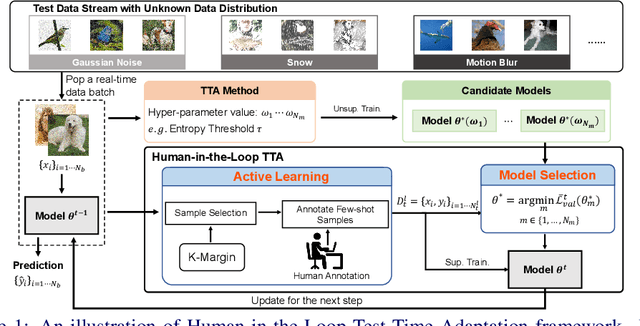
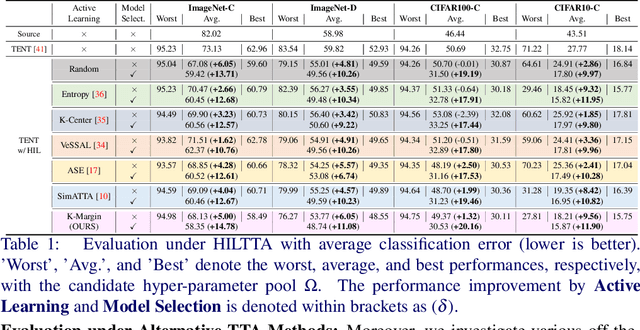
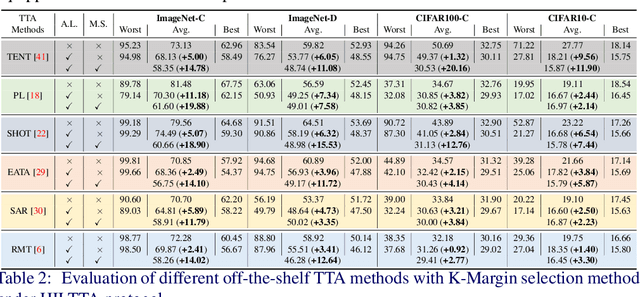
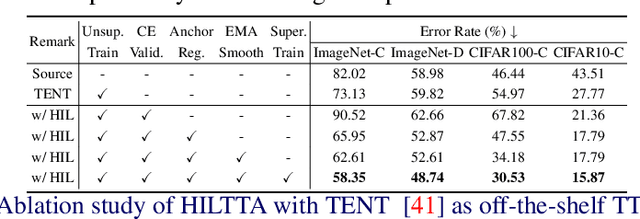
Abstract:Existing test-time adaptation (TTA) approaches often adapt models with the unlabeled testing data stream. A recent attempt relaxed the assumption by introducing limited human annotation, referred to as Human-In-the-Loop Test-Time Adaptation (HILTTA) in this study. The focus of existing HILTTA lies on selecting the most informative samples to label, a.k.a. active learning. In this work, we are motivated by a pitfall of TTA, i.e. sensitive to hyper-parameters, and propose to approach HILTTA by synergizing active learning and model selection. Specifically, we first select samples for human annotation (active learning) and then use the labeled data to select optimal hyper-parameters (model selection). A sample selection strategy is tailored for choosing samples by considering the balance between active learning and model selection purposes. We demonstrate on 4 TTA datasets that the proposed HILTTA approach is compatible with off-the-shelf TTA methods which outperform the state-of-the-art HILTTA methods and stream-based active learning methods. Importantly, our proposed method can always prevent choosing the worst hyper-parameters on all off-the-shelf TTA methods. The source code will be released upon publication.
Dynamic Shuffle: An Efficient Channel Mixture Method
Oct 04, 2023
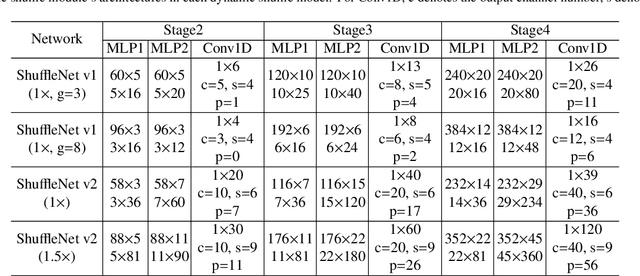

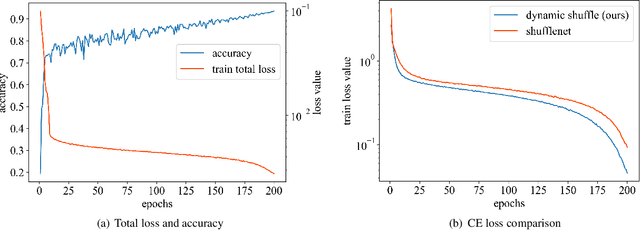
Abstract:The redundancy of Convolutional neural networks not only depends on weights but also depends on inputs. Shuffling is an efficient operation for mixing channel information but the shuffle order is usually pre-defined. To reduce the data-dependent redundancy, we devise a dynamic shuffle module to generate data-dependent permutation matrices for shuffling. Since the dimension of permutation matrix is proportional to the square of the number of input channels, to make the generation process efficiently, we divide the channels into groups and generate two shared small permutation matrices for each group, and utilize Kronecker product and cross group shuffle to obtain the final permutation matrices. To make the generation process learnable, based on theoretical analysis, softmax, orthogonal regularization, and binarization are employed to asymptotically approximate the permutation matrix. Dynamic shuffle adaptively mixes channel information with negligible extra computation and memory occupancy. Experiment results on image classification benchmark datasets CIFAR-10, CIFAR-100, Tiny ImageNet and ImageNet have shown that our method significantly increases ShuffleNets' performance. Adding dynamic generated matrix with learnable static matrix, we further propose static-dynamic-shuffle and show that it can serve as a lightweight replacement of ordinary pointwise convolution.
On the Robustness of Open-World Test-Time Training: Self-Training with Dynamic Prototype Expansion
Aug 19, 2023Abstract:Generalizing deep learning models to unknown target domain distribution with low latency has motivated research into test-time training/adaptation (TTT/TTA). Existing approaches often focus on improving test-time training performance under well-curated target domain data. As figured out in this work, many state-of-the-art methods fail to maintain the performance when the target domain is contaminated with strong out-of-distribution (OOD) data, a.k.a. open-world test-time training (OWTTT). The failure is mainly due to the inability to distinguish strong OOD samples from regular weak OOD samples. To improve the robustness of OWTTT we first develop an adaptive strong OOD pruning which improves the efficacy of the self-training TTT method. We further propose a way to dynamically expand the prototypes to represent strong OOD samples for an improved weak/strong OOD data separation. Finally, we regularize self-training with distribution alignment and the combination yields the state-of-the-art performance on 5 OWTTT benchmarks. The code is available at https://github.com/Yushu-Li/OWTTT.
A Noise-Robust Fast Sparse Bayesian Learning Model
Aug 20, 2019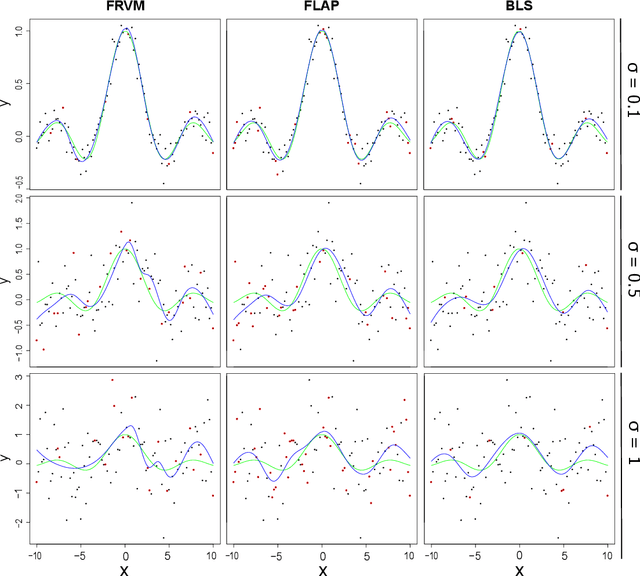

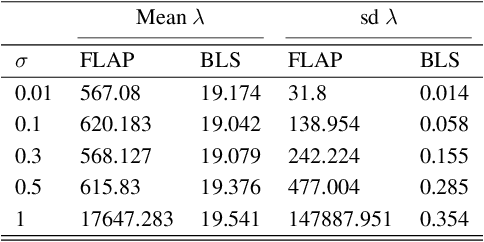
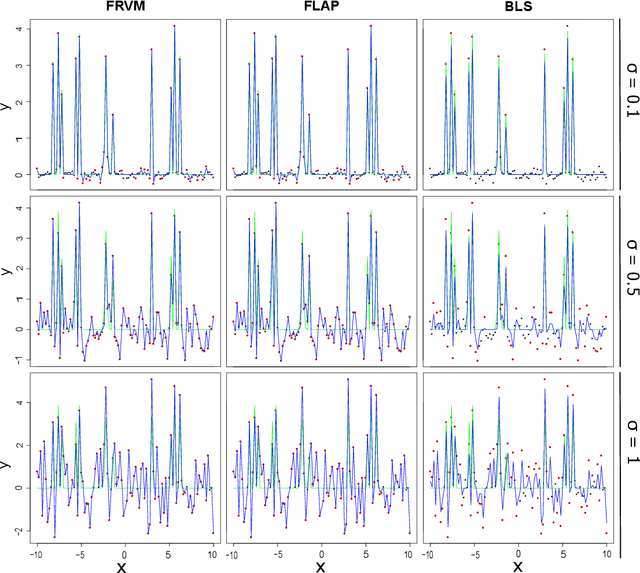
Abstract:This paper utilizes the hierarchical model structure from the Bayesian Lasso in the Sparse Bayesian Learning process to develop a new type of probabilistic supervised learning approach. This approach has several performance advantages, such as being fast, sparse and especially robust to the variance in random noise. The hierarchical model structure in this Bayesian framework is designed in such a way that the priors do not only penalize the unnecessary complexity of the model but also depend on the variance of the random noise in the data. The hyperparameters in the model are estimated by the Fast Marginal Likelihood Maximization algorithm and can achieve low computational cost and faster learning process. We compare our methodology with two other popular Sparse Bayesian Learning models: The Relevance Vector Machine and a sparse Bayesian model that has been used for signal reconstruction in compressive sensing. We show that our method will generally provide more sparse solutions and be more flexible and stable when data is polluted by high variance noise.
 Add to Chrome
Add to Chrome Add to Firefox
Add to Firefox Add to Edge
Add to Edge